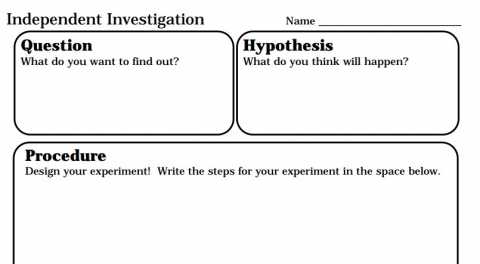What do tree rings tell us about climate change cycles? Video
Scientists demonstrate what tree rings tell us about the change in climate over time and how the climate changes in cycles.
Scientists demonstrate what tree rings tell us about the change in climate over time and how the climate changes in cycles.

Here is a handout to give students when they are about to do a science experiment. It will help them focus on the procedure of the scientific method.

Students can either label or put the skeleton together in this online activity. The better they do the higher their score. They can practice it as man times as they want.
This is a great video to show during your unit on adaptations and evolutionary changes. This video demonstrates how sharks have evolved over time to become the top of their food chain. It discusses how their bones and muscles have adapted to become more efficient.

This animated cartoon about eyes also comes with a quiz, an article, a labeling worksheet, and a word find.
This video discusses what comparative embryology in relation to the study of evolution. They do a great job talking about Ernst Haeckel who faked his drawings but had an idea that was actually pretty close. The video also discusses how sometimes scientists try to fit the evidence to meet a theory or hypothesis and therefore biasing their results.
This educational video explains the five main parts of evolution in simple, easy-to-understand terms. The video covers population effects, non-random mating, mutations, gene flow, and adaptations. Each concept is explained clearly, with examples to help students understand how these factors contribute to the process of evolution. By the end of the video, students will have a basic understanding of how these five parts work together to shape the evolution of species over time. Whether you're a student or just interested in learning more about evolution, this video is a great resource.
This video does a good job explaining what is meant by natural selection in the evolutionary process and why scientists believe in the Theory of Evolution. Descent with Modification, Common Descent, Galapagos Island Turtles, Charles Darwin, Selective Breeding, are all concepts discussed in the video.
This "Its OK to be Smart" video discusses why our bodies feel cold. Students will learn that it is all about heat transfer. The video will discuss convection, radiation, conduction, temperature, thermometers, matter, atoms, The Second Law of Thermodynamics, and why we would freeze in space.
This "It's OK to be Smart" video discusses the human nose and its awesome ability to sense smells. Please note that this video does talk about human sperm so you need to judge your students' maturity level. Nerves, olfactory receptors, eyes, and ears are also discussed in the video.